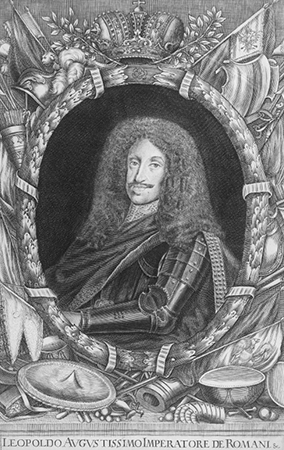The Emperor-Composer Leopold I (1640-1705)

Sample editions using Verovio
Large parts of Emperor Leopold's considerable musical oeuvre, most of which has survived in the Music Collection of the Austrian National Library, was edited by Guido Adler in the first two volumes of the Denkmäler der Tonkunst in Österreich: Musikalische Werke der Kaiser Ferdinand III., Leopold I. und Joseph I. Volume 1: Kirchenwerke (1892) and Volume 2: Gesänge aus Oratorien und Opern. Instrumentalcompositionen (1893). An overview of the edited works is available on the Denkmäler der Tonkunst in Österreich website. The following digital editions are not part of Guido Adler's publications.
Mottetto di sua Maestá Cesarea Leopoldo Primo. Heu! heu! heu! Peccatores.
Gavotte e Ciaccona di sua Maestá Caesarea
for solo violin, second violin, 2 violas, cembalo and bass.
The two dance movements each include a ritornello (Gavotta and Ciaccona) as well as six variations. The ritornello is played at the beginning, after the third and after the last variation, respectively. The ritornello is scored for five instruments, while the variations are played by solo violin and bass (or basso continuo).
The copies of the parts were made around 1675 and are now held in the Archiepiscopal Music Archive Kroměříž (Kremsier, shelfmark: A 904, Sehnal No. 309, RISM ID No. 550264281).
Ariae di sua Maestá Caesarea: Allemanda, Courent, Sarabande, Guige, Gavotta.
for violin, 2 violas, and basso di viola
The copies of the parts were made around 1670 and are now held in the Archiepiscopal Music Archive Kroměříž (Kremsier, shelfmark: A 892, Sehnal No. 306, RISM ID No. 550264278).
A visually adapted version of the Verovio JavaScript Toolkit expanded with bootstrap elements (zoom, page navigation, various music fonts, XML view and shifting between works) is used to display the music (rendering in the browser). In the current version of Verovio (Release 0.9.10), it is not yet possible to display additional text (title, performance, tempo), dynamics and figured bass.
Sample edition using MEI Snippet Viewer
Ariae di sua Maestáte Caesarea: Intrada, Sarabanda, Borea, Guige, Balletto, Ciaccona.
for violin, 2 violas, cembalo and bass
The copies of the parts were made between 1650 and 1699 and are now held in the Archiepiscopal Music Archive Kroměříž (Kremsier, shelfmark: A 918, Sehnal No. 307, RISM ID No. 550264279).
The MEI Snippet Viewer -Utility is used to present the music (rendering in the browser). A mouseover effect allows the MEI source code to be displayed. This technology also permits additional text, such as titles or figured bass, to be shown. One drawback of the Snippet Viewer is the visual appearance of the musical notation, which is not yet fully convincing. The utility, which is programmed in JavaScript, uses the VlexFlow music engraving library and is rendered client-side on the fly in the browser, like Verovio.
Leopold was born on 9 June 1640 in Vienna and died there on 5 May 1705. He was ruler of the Holy Roman Empire of the German Nation, ruler of Austria, a composer and a patron of the arts. As the second son of Ferdinand III, Leopold was originally destined for the Church and had been educated accordingly (theology, sciences, languages, music and literature); his music teachers were probably A. Bertali and M. and W. Ebner. Following the sudden death of his elder brother Ferdinand IV, who had been crowned Holy Roman Emperor in 1653, Leopold succeeded to the throne in 1654. While his political and military activity was characterised by hesitancy, he showed a high level of personal engagement in cultural matters (especially music) and the Catholic Counter-Reformation. Not only was he the most productive of the so-called "emperor-composers" (Ferdinand III, Leopold I, Joseph I and Charles VI); he also supported the court chapel and orchestra, which grew significantly during his reign, and firmly embedded the dramatic musical genres (opera, oratorio, sepolcro) in the court’s annual curriculum.
More than 400 dramatic musical productions were staged by the imperial court between 1658 and 1705, setting an example for many European courts. Leopold himself wrote instructions for the court orchestra, where the position of court composer was introduced in 1695 (partly as a result of the increased number of tasks; held by e.g. C. A. Badia, J. J. Fux, G. B. Bononcini), and the position of first director of music (Cavagliere/Direttore della Musica) in 1709 to reduce the workload of the Hofkapellmeister or court conductor, whose administrative duties increasingly prevented him from fulfilling his musical ones. Leopold’s own works follow the Venetian tradition of the mid-17th century (the style is not really developed further); many are sacred (oratorios and church music) and are marked by the emperor’s deep piety; besides these, Leopold also wrote a large number of arias for current court opera productions and smaller dramatic musical works. Leopold had a large music library (Bibliotheca cubicularia / bedroom library) with matching bindings in his private chambers (held today in the Music Collection of the Austrian National Library).
Source: Elisabeth Therese Hilscher, Oesterreichisches Musiklexikon